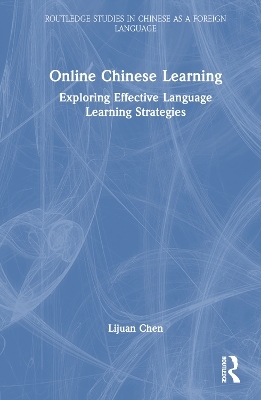
Online Chinese Learning
Routledge (Verlag)
978-1-032-47914-9 (ISBN)
Online Chinese Learning aims to investigate the types of language learning strategies (LLSs) that online Chinese learners use across asynchronous and synchronous learning environments in different learning contexts.
This book examines how the use of language learning strategies by online Chinese learners is influenced by the interactants; the characteristics of the specific learning context; and selected individual learner characteristics. This book will provide: (1) new and detailed information about students’ LLS use in online Chinese learning; (2) insights into how individual students adopt LLSs and technological tools to solve learning problems in various learning contexts; (3) an exploration of factors influencing LLS use; and (4) recommendations regarding LLS adoption, use, and training.
This book will be a valuable resource for university instructors in languages, language teaching methods, and second language acquisition, as well as researchers in languages, linguistics, and language learning and teaching.
Lijuan Chen gained her PhD from the School of Humanities, Languages and Social Science at Griffith University, Australia. Her research interests include technology-enhanced language teaching and learning, and in particular, language-learning-strategy adoption in online and distance learning, Chinese as a foreign language, and foreign language learners’ educational experiences. She has taught Chinese in China and Singapore, and teaches both Chinese and English in Australia.
Preface.
Chapter 1. Introduction.
1.1 Chinese language learning around the world.
1.2 Learning chanllenges and this book.
1.3 The Online Chinese Programme and the Research Project.
1.3.1 The online Chinese programme for this research project
1.3.2 Participants.
1.3.3 In-depth individual student studies.
1.3.4 Data collection and research instruments.
1.4 Organisation of the book.
1.5 Audience.
1.6 How this book is different .
Chapter 2. Review of related study fields.
2.1 Online learning and TELL.
2.1.1 Online learning.
2.1.2 TELL.
2.2 Chinese as a particularly difficult language for English speakers to learn.
2.3 LLSs and LLS research.
2.3.1 Definition of LLS.
2.3.2 LLS research.
2.3.3 TELL task types and LLS adoption.
2.3.4 LLS training.
2.4 LLS research in online language learning.
2.4.1 Affective strategies.
2.4.2 Cognitive strategies.
2.4.3 Social strategies.
2.4.4 Memory strategies.
2.4.5 Compensation strategies.
2.4.6 Metacognitive strategies.
2.4.7 LLSs specific to online learning.
2.4.8 Summary of LLS research in online language learning.
2.5 An overview of Chinese LLS research.
2.5.1 LLS adoption in Chinese language learning.
2.5.2 Chinese-character-learning strategy use.
2.5.3 LLS use in Chinese speaking.
2.5.4 LLS use in Chinese essay writing.
2.5.5 Chinese LLS use in TELL.
2.6 Different variables that influence LLS adoption.
2.6.1 Individual differences.
2.6.2 Motivation.
2.6.3 Language proficiency.
2.6.4 Learner autonomy.
2.6.5 Age.
2.7 Summary.
Chapter 3. The repertoire of LLSs in online Chinese learning.
3.1 Introduction.
3.2 LLSs obtained from the self-reported data.
3.2.1 LLS use by category.
3.2.2 Affective strategies.
3.2.3 Cognitive strategies.
3.2.4 Social strategies.
3.2.5 Memory strategies.
3.2.6 Compensation strategies.
3.2.7 Metacognitive strategies.
3.3 LLSs obtained from the observed data.
3.3.1 LLS adoption observed in the asynchronous learning environment
3.3.2 LLS adoption observed in the synchronous learning environment
3.4 Summary.
Chapter 4. Factors influencing LLS adoption.
4.1 Introduction.
4.2 The impact of the learning contexts and interactants on the participants’ LLS use.
4.2.1 The impact of the asynchronous and synchronous environments on the participants’ LLS use
4.2.2 The impact of the interactants on the participants’ LLS use.
4.3 The impact of the individual-learner characteristics on the participants’ LLS use.
4.3.1 Motives for learning Chinese and LLS use.
4.3.2 Learning goals and LLS use.
4.3.3 Age and LLS use.
4.3.4 Length of prior learning of Chinese and LLS use.
4.4 Summary.
Chapter 5. Individual LLS reports of the interviewees.
5.1 Introduction.
5.2 Student 5 (S5)
5.2.1 Background information, learning motives, goals, difficulties and strengths.
5.2.2 The key LLSs used by S5 and the tools used for these LLSs.
5.2.3 Summary of S5’s LLS report
5.3 Student 18 (S18)
5.3.1 Background information, learning motives, goals, difficulties and strengths.
5.3.2 The key LLSs used by S18 and the tools used for these LLSs.
5.3.3 Summary of S18’s LLS report
5.4 Student 8 (S8)
5.4.1 Background information, learning motives, goals, difficulties and strengths.
5.4.2 The key LLSs used by S8 and the tools used for these LLSs.
5.4.3 Summary of S8’s LLS report
5.5 Student 9 (S9)
5.5.1 Background information, learning motives, goals, difficulties and strengths.
5.5.2 The key LLSs used by S9 and the tools used for these LLSs.
5.5.3 Summary of S9’s LLS report
5.6 Student 10 (S10)
5.6.1 Background information, learning motives, goals, difficulties and strengths.
5.6.2 The key LLSs used by S10 and the tools used for these LLSs.
5.6.3 Summary of S10’s LLS report
5.7 Student 12 (S12)
5.7.1 Background information, learning motives, goals, difficulties and strengths.
5.7.2 The key LLSs used by S12 and the tools used for these LLSs.
5.7.3 Summary of S12’s LLS report
5.8 Student 13 (S13)
5.8.1 Background information, learning motives, goals, difficulties and strengths.
5.8.2 The key LLSs used by S13 and the tools used for these LLSs.
5.8.3 Summary of S13’s LLS report
5.9 Student 14 (S14)
5.9.1 Background information, learning motives, goals, difficulties and strengths.
5.9.2 The key LLSs used by S14 and the tools used for these LLSs.
5.9.3 Summary of S14’s LLS report
5.10 Student 15 (S15)
5.10.1 Background information, learning motives, goals, difficulties and strengths.
5.10.2 The key LLSs used by S15 and the tools used for these LLSs.
5.10.3 Summary of S15’s LLS report
5.11 Student 17 (S17)
5.11.1 Background information, learning motives, goals, difficulties and strengths.
5.11.2 The key LLSs used by S17 and the tools used for these LLSs.
5.11.3 Summary of S17’s LLS report
Chapter 6. Discussion and recommendations for online Chinese learning.
6.1 Introduction.
6.2 Key findings and recommendations in regard to LLS use in self-directed learning outside online classes.
6.2.1 Affective strategies.
6.2.2 Cognitive strategies.
6.2.3 Social strategies.
6.2.4 Memory strategies.
6.2.5 Metacognitive strategies.
6.2.6 Summary.
6.3 Key findings and recommendations in regard to LLS use in assessment-task completion
6.3.1 Cognitive strategies.
6.3.2 Social strategies.
6.3.3 Compensation strategies.
6.3.4 Summary.
6.4 Key findings and recommendations in regard to LLS use in the online class participation.
6.4.1 Cognitive strategies.
6.4.2 Social strategies.
6.4.3 Summary.
6.5 Two important observations from this research project
6.5.1 The importance of technology in LLS use.
6.5.2 The complexity of LLS classification.
6.6 Summary.
Chapter 7. Conclusion.
7.1 Introduction.
7.2 Contributions of this book.
7.3 Implications for online language teaching and learning.
7.4 Limitations of this research project.
7.5 Recommendations for future research.
Appendix I: Survey questionnaire.
Appendix II: Interview questions.
Index
| Erscheinungsdatum | 24.02.2024 |
|---|---|
| Reihe/Serie | Routledge Studies in Chinese as a Foreign Language |
| Zusatzinfo | 61 Tables, black and white; 2 Line drawings, black and white; 16 Halftones, black and white; 18 Illustrations, black and white |
| Verlagsort | London |
| Sprache | englisch |
| Maße | 156 x 234 mm |
| Gewicht | 630 g |
| Themenwelt | Schulbuch / Wörterbuch ► Wörterbuch / Fremdsprachen |
| Geisteswissenschaften ► Sprach- / Literaturwissenschaft ► Anglistik / Amerikanistik | |
| Geisteswissenschaften ► Sprach- / Literaturwissenschaft ► Literaturwissenschaft | |
| Geisteswissenschaften ► Sprach- / Literaturwissenschaft ► Sprachwissenschaft | |
| Sozialwissenschaften ► Pädagogik | |
| ISBN-10 | 1-032-47914-0 / 1032479140 |
| ISBN-13 | 978-1-032-47914-9 / 9781032479149 |
| Zustand | Neuware |
| Informationen gemäß Produktsicherheitsverordnung (GPSR) | |
| Haben Sie eine Frage zum Produkt? |
aus dem Bereich


